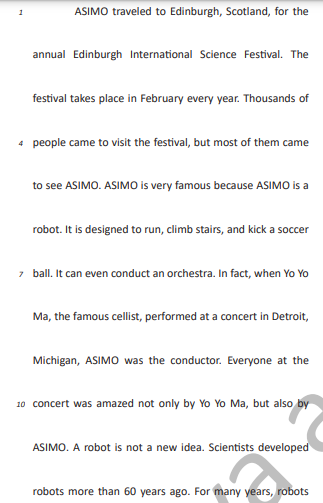Questões de Concurso
Sobre inglês nível médio
Foram encontradas 1.642 questões
Resolva questões gratuitamente!
Junte-se a mais de 4 milhões de concurseiros!
Concerning the text, judge the item.
The date of the festival is not mentioned in the text.
Concerning the text, judge the item.
The science festival happens once a year in Edinburgh.
Text for items from 16 to 20.
1 Nowadays, occupational therapists have access
to many technological features that aid patients in
overcoming their physical limitations.
4 While many traditional OT methods are still
highly effective, using technology can help with patient
engagement, especially in the case of young children.
7For example, a child whose treatment includes drawing
or coloring can use an iPad, instead of crayons, messy
markers and coloring books to practice these skills.
10 Elderly patients can use virtual assistants, like
Alexa or Siri, to control their environment without having
to get up or ask others for help. While teaching patients
13 how to use a virtual assistant may sound unconventional,
keep in mind the goal of occupational therapy is to help
someone become more independent, which is something
16 a virtual assistant does.
Internet: (with adaptations).
The modal verb in “can use an IPad” (line 8) indicates
Text for items from 16 to 20.
1 Nowadays, occupational therapists have access
to many technological features that aid patients in
overcoming their physical limitations.
4 While many traditional OT methods are still
highly effective, using technology can help with patient
engagement, especially in the case of young children.
7For example, a child whose treatment includes drawing
or coloring can use an iPad, instead of crayons, messy
markers and coloring books to practice these skills.
10 Elderly patients can use virtual assistants, like
Alexa or Siri, to control their environment without having
to get up or ask others for help. While teaching patients
13 how to use a virtual assistant may sound unconventional,
keep in mind the goal of occupational therapy is to help
someone become more independent, which is something
16 a virtual assistant does.
Internet: (with adaptations).
Choose the opposite adjective to “Elderly” (line 10).
Text for items from 16 to 20.
1 Nowadays, occupational therapists have access
to many technological features that aid patients in
overcoming their physical limitations.
4 While many traditional OT methods are still
highly effective, using technology can help with patient
engagement, especially in the case of young children.
7For example, a child whose treatment includes drawing
or coloring can use an iPad, instead of crayons, messy
markers and coloring books to practice these skills.
10 Elderly patients can use virtual assistants, like
Alexa or Siri, to control their environment without having
to get up or ask others for help. While teaching patients
13 how to use a virtual assistant may sound unconventional,
keep in mind the goal of occupational therapy is to help
someone become more independent, which is something
16 a virtual assistant does.
Internet: (with adaptations).
The verb “does” (line 16) in “which is something a virtual assistant does” (lines 15 and 16) is conjugated in the 3rd person singular to agree with the subject
Text for items from 16 to 20.
1 Nowadays, occupational therapists have access
to many technological features that aid patients in
overcoming their physical limitations.
4 While many traditional OT methods are still
highly effective, using technology can help with patient
engagement, especially in the case of young children.
7For example, a child whose treatment includes drawing
or coloring can use an iPad, instead of crayons, messy
markers and coloring books to practice these skills.
10 Elderly patients can use virtual assistants, like
Alexa or Siri, to control their environment without having
to get up or ask others for help. While teaching patients
13 how to use a virtual assistant may sound unconventional,
keep in mind the goal of occupational therapy is to help
someone become more independent, which is something
16 a virtual assistant does.
Internet: (with adaptations).
In the period “Nowadays, occupational therapists have access to many technological features that aid patients in overcoming their physical limitations” (lines from 1 to 3), the adverb “nowadays” (line 1) can be correctly replaced by
Observe o seguinte trecho do texto:
"Instead, email, instant messaging, remote-meeting apps, work-flow and project-management software can feel like buckets with holes in the bottom [...]".
O emprego do termo "instead", no contexto em que se encontra, indica que, no ambiente de trabalho, as
ferramentas digitais
READ THE TEXT AND ANSWER THE QUESTION:
Chatbots could be used to steal data, says cybersecurity agency
The UK’s cybersecurity agency has warned that there is an increasing risk that chatbots could be manipulated by hackers.
The National Cyber Security Centre (NCSC) has said that individuals could manipulate the prompts of chatbots, which run on artificial intelligence by creating a language model and give answers to questions by users, through “prompt injection” attacks that would make them behave in an unintended manner.
The point of a chatbot is to mimic human-like conversations, which it has been trained to do through scraping large amounts of data. Commonly used in online banking or online shopping, chatbots are generally designed to handle simple requests.
Large language models, such as OpenAI’s ChatGPT and Google’s AI chatbot Bard, are trained using data that generates human-like responses to user prompts. Since chatbots are used to pass data to third-party applications and services, the NCSC has said that risks from malicious “prompt injection” will grow.
For instance, if a user inputs a statement or question that a language model is not familiar with, or if they find a combination of words to override the model’s original script or prompts, the user can cause the model to perform unintended actions.
Such inputs could cause a chatbot to generate offensive content or reveal confidential information in a system that accepts unchecked input.
According to the NCSC, prompt injection attacks can also cause real world consequences, if systems are not designed with security. The vulnerability of chatbots and the ease with which prompts can be manipulated could cause attacks, scams and data theft. The large language models are increasingly used to pass data to third-party applications and services, meaning the risks from malicious prompt injection will grow.
The NCSC said: “Prompt injection and data poisoning attacks can be extremely difficult to detect and mitigate. However, no model exists in isolation, so what we can do is design the whole system with security in mind.”
The NCSC said that cyber-attacks caused by artificial intelligence and machine learning that leaves systems vulnerable can be mitigated through designing for security and understanding the attack techniques that exploit “inherent vulnerabilities” in machine learning algorithm.
Adapted from: The Guardian, Wednesday 30 August 2023, page 4.

